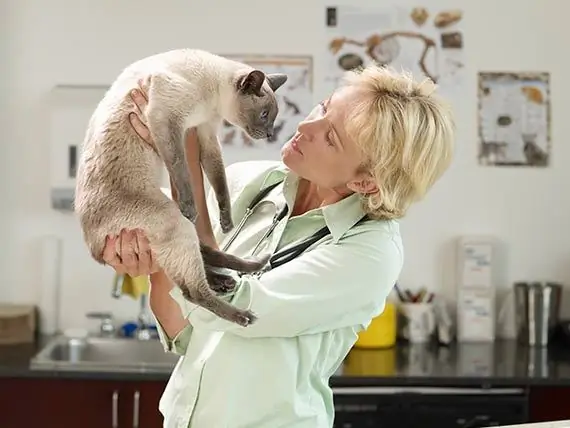
- מְחַבֵּר Daisy Haig [email protected].
- Public 2024-01-31 10:58.
- שונה לאחרונה 2025-06-01 06:47.
אז בשביל מה מבחן הקאקה המביך הזה, בכל מקרה?
זה מספיק מלחיץ שמוט פלסטיק יפר את הישבן של חיית המחמד שלך, נכון? אז מה הטעם?
אתה אומר: אם המטרה היא להפוך את חיית המחמד שלי לבריאה יותר וללא טפילים, אז אני אמון על שיקול הדעת שלך, אבל אני חייב לומר, בדיקת צואה היא סוג של ענישה אכזרית ויוצאת דופן. אני לא מקבל סוג כזה של השפלה עד שאני בן ארבעים, נכון? וצואה לא כל כך מועילה, נכון?
אני אומר: בתור התחלה, אתה לא צריך לחיות המחמד שלך להיכנע למוט המסורתי. בדרך כלל ניתן להשיג מדגם טרי בבוקר (או אחר הצהריים) לפני הביקור השנתי שלך או בכל עת שחיית המחמד שלך סובלת מתופעות במערכת העיכול. זה לא כל כך קשה, באמת. ואם העיתוי לא נכון בדיוק (הצואה לא צריכה להיות יותר משעה לקבלת התוצאות הטובות ביותר), בית החולים הווטרינרי שלך בוודאי לא ישלול ממך את הזכות להביא דגימה טרייה במיוחד בזמן שנוח לך. הַבטָחָה.
וכן, בדיקות צואה, אם כי יחסית זולות ושגרתיות, הן הכרחיות. אך כפי שהפוסט הזה יוכיח, נכון גם שלא כל בדיקות הצואה ילקחו זיהום בטפיל אצל חיות המחמד שלך. לכן ייתכן שיהיה צורך בבדיקות צואה צונתיות.
עכשיו למטרה העיקרית של המבחן:
וטרינרים תמיד מחפשים טפילים שעשויים למצוא את דרכם למערכת העיכול של חיות המחמד שלכם. בטח, אנו בני האדם יכולים לקבל גם טפילים, אך אורחות חיינו המודרניים נוטים להיות פחות תורמים לזיהום טפילים. (מתי בפעם האחרונה הלכת לרחרח בחצר, שפתיים על הקרקע, רק כדי שתשאף טורד חתולי או שניים?)
כן, חיות מחמד מקבלות הרבה טפילים. הנה דגימה של טפילי מערכת העיכול הנפוצים ביותר שאני רואה כאן [בגן עדן הטפיל שהוא דרום פלורידה למחצה]:
תולעים עגולות בכלבים וחתולים.
תולעי קרס בחיות מחמד
תולעי שוט אצל חיות מחמד
ג'יארדיה בחיות מחמד

דפיקות כבד אצל חיות מחמד
<מחלקת דמויות =" title="תמונה" />
דפיקות כבד אצל חיות מחמד
coccidia in pets
i’ll not go into the gory details on each but you can click on the links and check out the info for a better understanding of how these parasites can potentially affect your pets and even your human family.
sure, pet-popular parasites don’t often infect humans in the so-called, “developed” nations all of you reading this likely live in, but that doesn’t mean it doesn’t happen. roundworms and hookworms are still a factor in humans in the us, as is giardia, which will give you the nastiest case of diarrhea you can imagine short of amoebic dysentery.
since veterinarians are also on the front lines when it comes to public health, consider that fecal exams are not just necessary for healthy pets, they’re essential for healthy humans, too, more so if your family members are very young children, very old adults or otherwise immunocompromised (transplant patients, hiv-positive humans, chemo recipients, etc.).
how do we identify these critters in the fecal exam?
the short answer: with a microscope.
the long answer: we take a tiny sample of your pet’s stool (very fresh is always best). a few grams is enough (think an eighth of a teaspoon if that’s easier). then we put it through one of three processes.
1. the smear: we take about a half gram of stool and smear it onto a microscope slide to search for parasites (and bacteria) directly. many times we’ll see them swimming about. finding evidence of parasites in a simple smear is often indicative of severe infection.
2. the float: this method relies on mixing the stool with a special solution. it filters out the big pieces of stool in a tube or other cylindrical vessel and allows the eggs and other small critters to float up to the top, buoyed by the solution’s specific gravity. a microscope slide’s cover slip is typically used to recover the floaters. some parasites, however, aren’t amenable to flotation. eggs seem to do best through this method.
3. centrifugation: spinning the heck out of stool in a centrifuge when it’s mixed in a sugar solution picks up about 50% more parasite eggs and oocysts than through flotation. therefore, i like this method best for worm eggs, giardia, and coccidia--though i’d never go without a smear. problem is, most hospitals don’t yet use this method. it’s more expensive than others and research demonstrating it’s much greater efficacy is fairly recent.
so now you know the truth: not all fecal exams are created equal. not only does this test rely on careful selection of materials and methods, it also requires a trained eye. in our practice, for example, one of our techs detects parasites about 50% more often than the veterinarians and other techs/assistants. (that’s why we also do floats so that she can check them all at her convenience when she comes back from her day off.)
it’s also true that even a parasite-infected animal will often not come up positive on a fecal test. human error and equipment choice are factors, but so is the parasite itself. sometimes they do not make themselves known in the stool. worms sometimes aren’t shedding their eggs and subclinical (low-grade or smoldering) infections may not reveal much, either.
again, that’s why it’s important to perform this test as often as is reasonable. for all dogs and cats at least three times during the first few months of life. i want to see at least two negative tests in a row, a month apart, before i’ll feel comfortable that my patient is parasite-free.
for adults, once a year is great--that is, unless they show gastrointestinal illnesses. in this case, serial fecal tests make sense--or at least one every time the symptoms recur until a definitive diagnosis is made (whether it’s parasites or something else).
ultimately, fecal tests are a critical component of our veterinary hat of tricks. doing without may seem like the economically wisest thing in the absence of gastrointestinal symptoms, but consider: parasites can wear pets down in ways you might not expect. and it’s never wrong to be too safe in the presence of diseases that may also affect your family. ‘nuff said.
מוּמלָץ:
בריאות הנפש שלך סובלת כאשר חיית המחמד שלך חולה

האם אי פעם טיפלת בחיית מחמד חולה קשה? אם כן, סביר להניח שתסכים לתוצאות של מאמר שפורסם לאחרונה ומצא כי בעלי חיות לוויה חולות קשה חווים "נטל מטפל"
כמה בטוחים כימיקלים לדשא לחיות מחמד? - האם הדשא המושלם שלך הורג את חיית המחמד שלך?

כאשר האמריקנים שואפים לדשא הירוק המושלם, הם משתמשים במגוון רחב של כימיקלים כדי להשיג את יעדיהם. למרבה הצער, יש לכך השפעה מזיקה על הסביבה ועל בעלי החיים החיים בה. כיצד משפיעים מוצרי הדשא והגן על חיות המחמד שלנו? קרא עוד
כיצד נקבע הפרוגנוזה של חיית המחמד שלך על ידי הווטרינר שלך

"כאשר אנו מתמקדים יותר מדי בגורמים פרוגנוסטיים ספציפיים, אנו מאבדים את התמונה הגדולה יותר." לפני שהמליץ על הטיפול במטופליה, ד"ר אינטיל מתמקד בזכור שכל בעל חיים הוא אורגניזם שנוצר באופן ייחודי ושצריך לשקול גורמים רבים. למידע נוסף על "הגורמים הפרוגנוסטיים" של חיית המחמד שלך וכיצד הם קובעים את הטיפול בווטרינר היומי של היום
האם אתה סומך על בריאות חיית המחמד שלך לעוזר הווטרינר שלך?

האם אתה סומך על בריאותו של חיית המחמד שלך לעוזר הווטרינר שלך? תוספת של טיפול "וטרינרי" באמצע הדרגה, בדומה לעוזר הרופאים ברפואה אנושית, יכולה לחסוך זמן וכסף לצרכנים ולהפוך טיפול וטרינרי לאזורים גיאוגרפיים נמוכים יותר. קרא עוד
איך לדעת אם חיית המחמד שלך זקוקה לנמק (ומה בכלל נמק?)

נמק, נתיחת בעלי חיים, חיות מחמד, כלב, חתול
